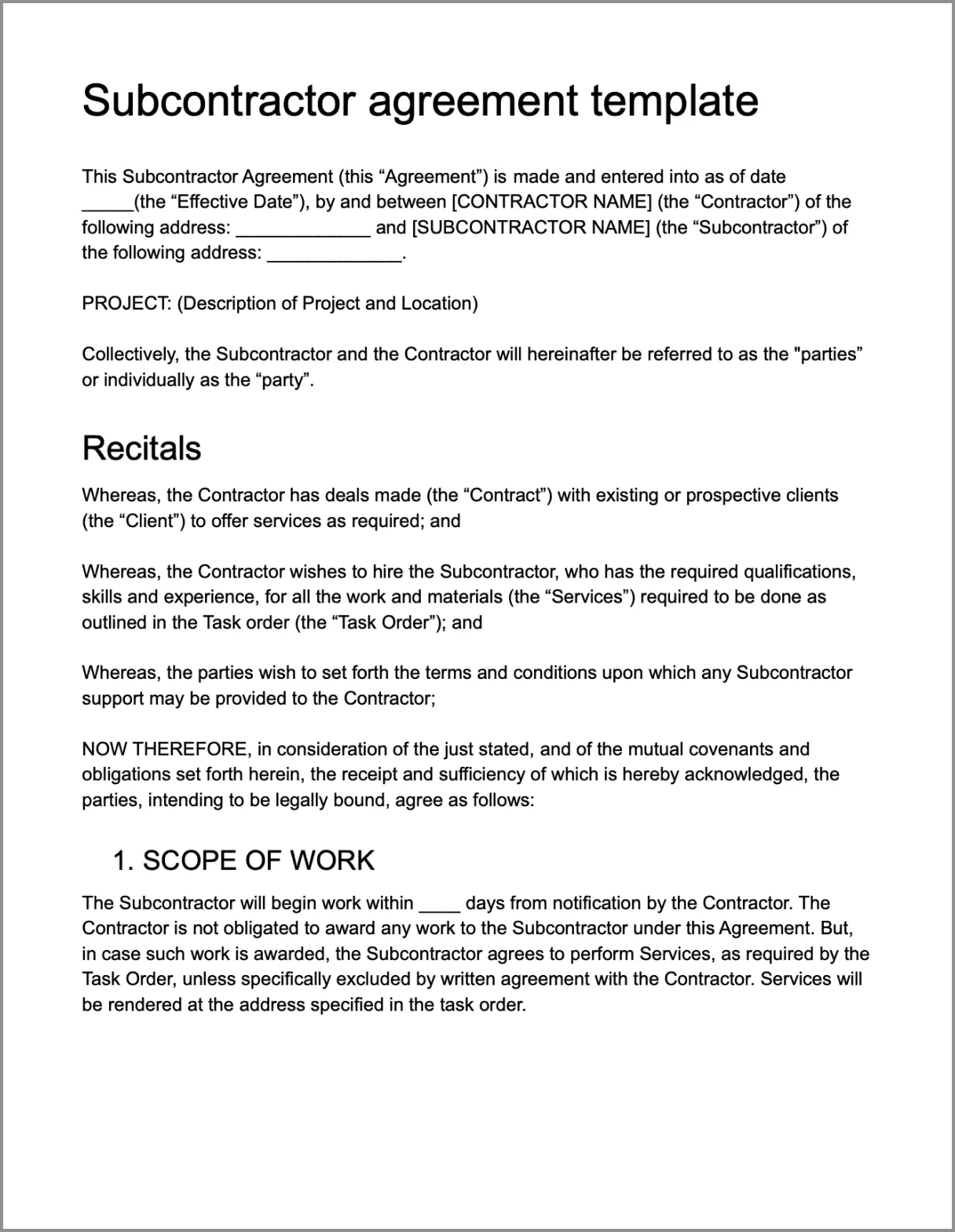Free Subcontractor Agreement Template in PDF
As a general contractor, you may want to hire a skilled independent vendor – aka a subcontractor – to support you on a job. To formalize this partnership, both parties must sign off on a comprehensive and legally binding subcontractor agreement. To make things as simple as possible for you, we have put together a free subcontractor agreement template (Word).
If you are just here for the free downloadable template, here you go. But, if you want a better understanding of the agreement and the purpose behind each clause, read on.
Before you dive in, let’s be clear about one thing: this is about a 7-minute read, and it has quite a bit of legal information. Don’t let that scare you off, though – it’s very important to understand all the aspects of any agreement you’re proposing and signing.
Unpacking the free subcontractor agreement template word
A typical subcontractor agreement needs to comply with state laws and be easy to comprehend. It should also include everything from the scope of the work and payment terms to responsibilities and means of termination.
Before we get into all that, it’s important to introduce the various parties involved in the partnership and define their roles. It should also include the agreement start date.
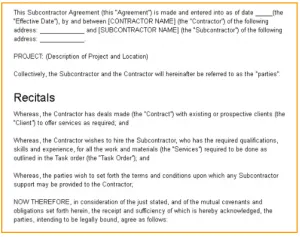
Define the specifics of the job
Start the contract with a guide to what sort of work the subcontractor will have to complete. Also, set the subcontractor’s expectations regarding the volume of work that will be delegated to them within the agreement timeline.
Note: From this section onwards, you will also see several mentions of ‘Task Orders.’ This refers to smaller contracts that contain all the details (eg: scope, cost, and schedule) of each specific job that is assigned to the subcontractor. It is usually raised after the subcontractor agreement is signed.
Not only will you outline the essential elements that must be present in a task order for each job, but you will also specify how to address any amendments to a task order. The term (also known as the duration) of the agreement should also be explicitly stated in this section.
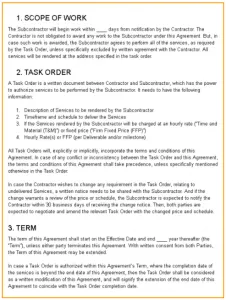
Elaborate on the compensation
What type of goods and/or services are you paying the subcontractor for? Does the contractor need to account for overtime performed by the subcontractor’s employees? Who pays for incidental expenses incurred while the service is being rendered? This section of the sub contractor agreement must answer all of these questions.
You may also want to mention who is responsible for paying the GST, HST, or any other transaction taxes. A provision about the payment terms will nicely round out this part of the agreement.

Set basic limitations for the subcontractor
What if, during their association with your client, the subcontractor learns of new business opportunities? In such circumstances, you wouldn’t want them to poach the client from you. So, in this section, you should clarify how much access the subcontractor has to the client, and prohibit them from pursuing new RFPs with the client during the agreement period.
It would also be sensible to add a clause that prevents the subcontractor from further delegating the jobs outlined in the Task Order to another subcontractor.

Outline the confidentiality, IP, and non-compete clauses
When you start working with a subcontractor, you will be exchanging lots of proprietary and/or confidential information. You will also be creating unique processes and goods/services. It’s important that limits are set to determine how the subcontractor is allowed to use or share this information. You will also need to mention who (client, contractor, or subcontractor) has the rights to the project knowledge and output.
Additionally, for hyper-competitive markets, be sure to add a non-compete clause which prevents the subcontractor from working with your direct competitors for a fixed period of time.
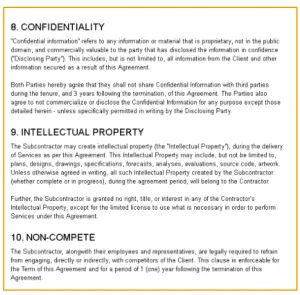
Mention clauses that safeguard you from liabilities
You can’t just hope that your subcontractor will show up on time and complete the tiling for the new housing project you are working on! Even the most trusted subcontractors may not always hold up their end of the deal. There could also be breaches of the independent contractor agreement in the form of damages due to negligence, or legal fees to be dispensed.
So, in this section, you need to outline who will be responsible for delays and defaults, and which steps either party can take to terminate the contract. Most contractors also add an insurance clause, which makes subcontractors liable to have comprehensive insurance coverage.
Pro tip: Consider adding a licensing clause that verifies that the subcontractor is licensed to perform work in the state.
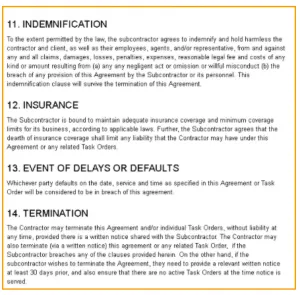
Make note of these general, yet essential provisions
Here are some legal terms that are standard across many types of agreements. A few questions that need to be answered in this section are:
- Which state’s laws govern this agreement’s interpretation and enforcement?
- What are the limits beyond which both parties are not liable for damages?
- What happens if a few provisions in the agreement are deemed invalid?
- Do both parties agree that the contract is complete and final?
- How will both parties communicate with each other on themes connected to this agreement?
Pro tip: It’s important to include a standard dispute resolution clause here. For a more affordable dispute resolution process than going to court, the provision must state that disputes will be settled by a neutral and non-binding mediator or arbitrator.
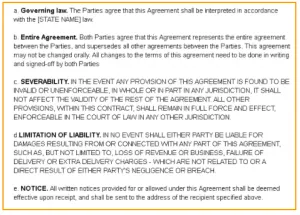
Make your contract legally binding with eSignatures
Arguably, this section is the most critical part of the contract. Why? Because if the document is not signed by both parties, it will not hold up in court.

Why do you need a free subcontractor agreement template?
The original work agreement between you and your client holds you liable to the client. However, it does not include any provisions for the subcontractor that you go on to hire. This is where the need for a subcontractor agreement arises. This contract can ensure you do not have to take on any liability related to the independent third party’s work on the project.
Let’s assume that you are awarded a building construction project with a vast scope of work. Among your assigned tasks, tiling is a job which is outside of your business’s core competencies. So, you employ a subcontractor (say, Jack) with the relevant labor and tools to help out. But what if Jack does not deliver quality services or refuses to meet deadlines? You need the legal means to hold his company responsible.
A subcontractor agreement clarifies the specifics of the relationship between you and Jack, eliminating all confusion about what is expected of each party. Having a well-drafted document in place can also help lower your insurance costs. On the other hand, it can aid subcontractors in safeguarding their interests and avoiding potentially messy disputes related to payment defaults or scope of work.
Pro tip: Before you engage with a subcontractor, make sure that your agreement with the client allows you to outsource part of your contractual obligations. If not, the client could easily sue you for damages caused by the subcontractor.
Final Word
That’s it. You are now fully equipped to use the downloadable and free subcontractor agreement template (Word).
You will find yourself using this subcontracting template a lot more often if you deal with construction or information technology clients, where each project has diverse and elaborate requirements.
In such cases, you could save this contract template to your Signeasy account and reuse it whenever you onboard a new subcontractor. Think of the time you'll save if you don’t need to draft a new contract every time! This helpful blueprint can be personalized and digitally signed before sharing with the subcontractor, anytime and from anywhere.
Pro Tip: Each subcontracting agreement is unique, so its clauses need to be tailored to suit the local laws and specific circumstances. Therefore, be sure to seek legal counsel before using this free subcontractor agreement contract template.
For more templates, sign up for a Free Trial today!
FAQs on free subcontractor agreement template word
Now that you have seen how helpful it is to have a subcontractor agreement template, read on to answer some of the most commonly asked questions about these documents.
How do I write a subcontractor agreement?
- Open the free subcontractor agreement template (Word) on SignEesy
- Make edits to the template document: add due dates, project details, costs, etc..
- Send a copy to the subcontractor for review and suggest edits if required
- Once approved, add a eSignature to the template
- Send it to the subcontractor for their signature
What should be included in a subcontractor agreement?
A free subcontractor agreement template should ensure that the contractor’s interests are protected. Be sure to include details like licensing, job specifics, timelines, timings, methods of resolving legal issues, and warranty. Also, you need to include a section for acknowledgement of all the terms of the subcontracting agreement by both parties.
What's a subcontractor agreement?
A subcontractor agreement is a document that legally binds contractors and subcontractors. It assures work to the contractor and payment to the subcontractor in exchange for the job done.
What is a master subcontract agreement?
A master subcontract agreement is an overarching agreement between the contractor and subcontractor for long-term associations. It doesn't get into the details of each mandate, but it does mention the basic terms and conditions of the partnership. The specifics of each job can be approved in a work authorization document.
Template Preview
